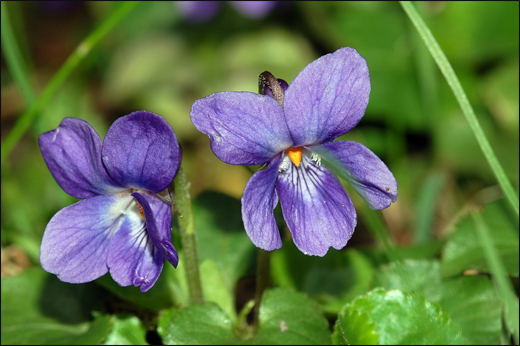Viola odorata Linn./ Banafasha – Ayurvedic Properties, Practical Uses & Medicine
Abstract
Viola odorata Linn., commonly known as Sweet Violet, is a fragrant medicinal plant widely used in traditional medicine systems, including Ayurveda. It is renowned for its therapeutic properties, such as anti-inflammatory, expectorant and cooling effects. Viola odorata is a small, perennial herb known for its sweet-smelling purple flowers. It has been used traditionally in Ayurveda for treating respiratory disorders, skin diseases, and as a mild sedative. The plant’s therapeutic effects are attributed to its rich phytochemical composition, including flavonoids, alkaloids and essential oils. This article reviews its botanical classification, traditional uses, chemical constituents, and potential health benefits.

Introduction
Banapsa/ Banafasha, or Viola odorata, is traditionally used to treat ailments such as cough, asthma, fever accompanied by a burning sensation and body aches. It is commonly included as an ingredient in many herbal cough syrups. One of its chemical constituents, Cycloviolacin O2, has demonstrated potential anticancer properties. According to the Bhavaprakasha Nighantu, it is categorised under the Parishisht section. The plant has a long history of use in ethnomedicine. The terms “Viola” and “Violet” generally refer to small-flowered plants that can be annual or perennial. Most species bloom in spring with chasmogamous flowers, which have fully developed petals and are insect-pollinated. Many species are cultivated for their attractive flowers in gardens. While the majority of Viola species are native to temperate regions of the northern hemisphere, some are also found in diverse locations such as Hawaii, Australasia and the Andes.
Scientific Classification
- Kingdom : Plantae
- Division : Magnoliophyta
- Class : Magnoliopsida
- Order : Malpighiales
- Family : Violaceae
- Genus : Viola
- Species : Viola odorata Linn.
Synonyms
- Banafsa
- Banafsha
- Vanafsha
Vernacular Names
- Hindi : Banafsa, Basanti
- Sanskrit : Sheetapushpa
- English : Sweet Violet, Wood Violet, Common Violet, Garden Violet
- Bengali : Banafsha
- Marathi : Banphool
- Tamil : Vayilethe
- Telugu : Neelatamba
- Kannada : Nila Ganjike
- Gujarati : Bagabanosa
- Unani : Banafshah
- Urdu : Banaphsa
Habitat
Viola odorata naturally grows in temperate regions, particularly in the Himalayan foothills, and other parts of Asia and Europe. It thrives in cool, moist environments such as shady woodlands, grasslands and along riverbanks. The plant prefers well-drained, fertile soils and is commonly found at altitudes between 600 to 2400 meters above sea level.
Morphology
Viola odorata is a low-growing, creeping herb with heart-shaped, serrated leaves that are thick and soft. The plant produces solitary, fragrant, purple to violet flowers, which bloom in early spring. The flowers have five petals, with the lower petals often featuring a spur. The stems are slender and sometimes hairy. The plant propagates both by seeds and creeping rhizomes.
Classical Categorisation
Bhavprakash Nighantu, page number 807
Ayurvedic Properties
- Taste (Rasa) – Bitter (Tikta), Pungent (Katu)
- Physical property (Guna) – Light (Laghu), Unctuous (Snigdha)
- Potency (Veerya) – Hot Potency (Usna)
- Post-digestion effect (Vipaka) – Katu (Pungent)
- Effect on tridosha – Balance Vata and Pitta dosha
Therapeutic Properties
- Detoxifier
- Anti-cancer
- Expectorant
- Pain relief
- Sedative
- Laxative
- Digestive aid
- Anti-inflammatory
- Wound healer
- Skin care
- Rich source of Vitamin A & C
Systemic Actions
External Use
It has antimicrobial and anti-inflammatory properties. The paste is applied externally for conditions like headaches and various skin issues. The oil is beneficial in managing insomnia when used for massage or external application.
Internal Use
- Digestive System – It helps balance Pitta dosha and possesses antimicrobial and anti-inflammatory actions. Sweets made from its flowers are useful in liver-related disorders. Flowers act as a mild laxative, while the root has both purgative and emetic effects.
- Respiratory System – It helps pacify Kapha dosha and is useful in treating cough (Kasa), shortness of breath and related respiratory conditions.
- Circulatory System – Its root decoction supports healthy blood pressure levels and acts as a blood cleanser.
- Skin (Tvak) – It is beneficial in various skin ailments. It promotes sweating and helps eliminate toxins through the skin.
- Fever (Tapakrama) – It acts as a Jvaraghna (antipyretic), useful in reducing fever.
Chemical Composition
- Salicylic acid
- Violin (a glycoside)
- Volatile oil
- Rutin
- Cyanin (a flavonoid pigment)
- Colorless chromogen
- Glycoside of methyl salicylate
- Sugar
- Essential oil
- Alkaloid
- Odoratine (an alkaloid)
- Colouring matter
- Friedelin
- β-sitosterol
- Straight-chain alcohol
- Saponins
- Ionone
- Ionine
- Glucoside
- Methyl salicylic esters
- Flavonoids
- Glycosides
- Phenolic compounds
- Tannins
- Resins
- Sterols
- Triterpenes
- Anthocyanin
- Violanin chloride
- Tocopherol (Vitamin E) – high content in flowers
- Vitamin C
- Cycloviolacin
- Violanthin
- Methyl salicylate
- Potassium
- Magnesium
- Sodium
- Iron
Modern Overview
Antimutagenic Activities
A study was conducted to evaluate the antimutagenic activity of Banafshah (Viola odorata Linn., whole herb) using specific strains of Salmonella typhimurium (TA97, TA98, and TA100). The bacterial strains were cultured following the standard Maron and Ames protocol, with revival every 15 days on media containing L-histidine and D-biotin. The Salmonella/microsome assay was employed to assess the inhibition of sodium azide-induced mutagenicity. The herb extract showed strong antimutagenic potential, with 98% inhibition in TA97, 96% in TA98 and 77% in TA100 at a concentration of 50 μg/0.1 ml/plate. These findings support its potential as a natural antimutagenic agent.
Antidyslipidemic Activities
The antidyslipidemic effect of Viola odorata leaf extract was studied in anesthetized rats, showing a significant reduction in total cholesterol, triglycerides and LDL-C levels, along with an increase in HDL-C. This effect is likely attributed to its ability to inhibit lipid synthesis and absorption, as well as its antioxidant properties.
For Insomnia
The volatile oil extracted from the flowers of Viola odorata was evaluated for its effectiveness in managing chronic insomnia. Intranasal administration of the oil—one drop in each nostril at bedtime—for one month led to a significant improvement in sleep quality. There was a notable reduction in Insomnia Severity Index (ISI) scores, with results showing statistical significance (p < 0.05) after the treatment period.
Practical Uses
- Leaves of Viola odorata are used to treat swelling, inflammation, jaundice, headache and body pain.
- Fresh leaf paste is applied externally to reduce pain and inflammation.
- Dried flower powder is beneficial for promoting sleep.
- Inhalation of fresh flowers and leaves helps relieve headaches caused by heat, bile imbalance, and high blood pressure.
- Applying a paste of leaves and flowers or rinsing with Banafsha decoction treats headaches due to fever; infusion of Gule Banafsha is effective for headaches in children.
- Applying oil made from fresh flowers mixed with sesame and almond oils helps combat sleeplessness.
- Inhalation of fresh flowers also benefits those suffering from insomnia.
- Roghan Banafsha (Banafsha oil) helps liquefy impacted ear wax and, when applied on the chest, is effective against cough, especially in children.
- The oil can be used to reduce hair fall, heal skin wounds, and treat dry skin.
- Roghan Banafsha, alone or combined with Mastagi, is effective in treating scabies.
- The oil is used to relieve abdominal pain, soothe cough, and acts as a sedative.
- It is also effectively used for cephalalgia (headache) and insomnia.
- Applying a paste made of Banafsha and barley flour, or Banafsha leaves alone, helps dissolve hot inflammations.
- Plasters made from Banafsha and barley flour or just Banafsha leaves are used to treat hot inflammations like pimples.
Part Used
- Flowers
- Whole plant
Dosage
Powder – 3-6 gm
Planet Ayurveda Medicines
Conclusion
Viola odorata Linn. is a valuable medicinal herb with a wide range of therapeutic applications, particularly in respiratory and skin disorders. Its pleasant fragrance and calming properties add to its traditional popularity. Supported by its phytochemical richness, the plant continues to be an important natural remedy in Ayurveda. Further research and clinical studies can help better understand and harness its full potential.



